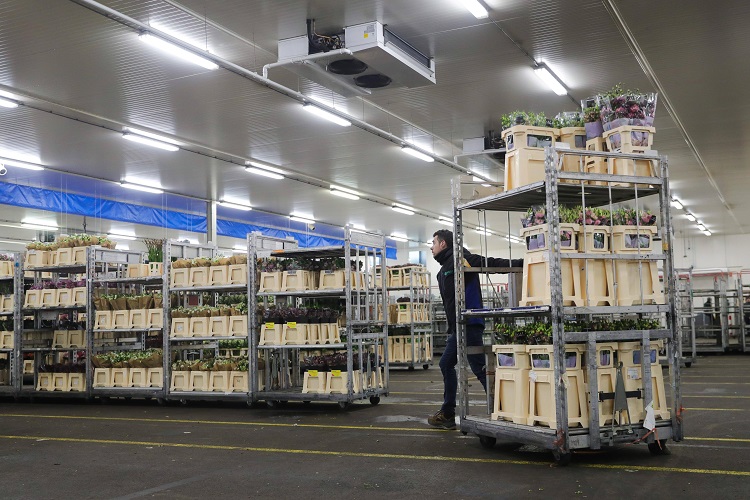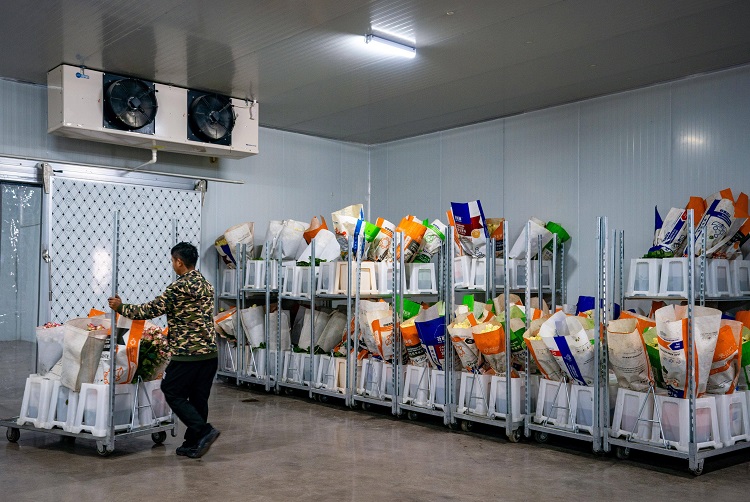Why Are Fresh Flowers Available Year-Round? The Role of Cold Storage
Many people wonder why some flower shops can offer fresh flowers all year round. While greenhouse cultivation plays a role, another major factor is cold storage technology. Most large flower retailers own or rent cold storage rooms specifically designed to preserve the freshness of flowers.
Without proper preservation methods, flowers will wilt quickly. So, how are flowers actually stored to maintain their quality? Here are three key flower cold storage and preservation techniques widely used in the industry.

Interior scene of the completed and put into use flower cold storage
1. Temperature-Controlled Storage
This includes basic temperature-controlled rooms, cold storage refrigeration, and ice-point-controlled storage.
- Basic storage utilizes local natural conditions to maintain an environment suitable for flowers. However, humidity is hard to control, and good ventilation is required.
- Cold storage involves refrigerated rooms with thermal insulation and mechanical cooling. Temperature, humidity, and airflow are adjusted based on flower variety requirements. This is currently the most widely used flower preservation method.
- Ice-point-controlled storage uses advanced technology to maintain temperatures just above the freezing point. This method retains bright colors and fresh appearance, and although currently limited in use, it’s expected to grow in popularity soon.
2. Controlled Atmosphere (CA) Storage
Includes CA storage, MA (Modified Atmosphere), plastic film bag storage, and MAP (Modified Atmosphere Packaging).
- CA Storage artificially adjusts the composition of gases (like reducing oxygen, increasing CO₂) in the storage room. When combined with low temperatures, it outperforms conventional refrigeration.
- MA Storage adjusts the gas mixture inside sealed packaging to extend shelf life. CO₂ and O₂ are the most commonly used gases.
- Plastic Film Bag Storage creates a sealed mini-environment using plastic film to adjust internal gas content. This technique is commonly used in countries like the US and France, and has recently been adopted in major Chinese cities like Shanghai and Beijing.
- MAP Packaging first vacuums the package, then fills it with a mixed gas. Though it’s just beginning in the flower industry, it’s widely used in food preservation.
Compared to traditional refrigeration, this precisely controlled environment significantly improves the freshness of flowers, fruits and vegetables and extends their shelf life (learn more about its principles and advantages: Controlled Atmosphere Storage: An Advanced Solution for Fruit & Vegetable Preservation).

Actual scene of flower cold storage in normal use
3. Vacuum and High-Pressure Preservation
- Vacuum Storage places flowers in sealed chambers and removes most air to reduce pressure to about 10 kPa. This creates a low-oxygen environment that slows respiration and aging. Temperature is kept between 1–18°C with relative humidity over 95%. This method extends shelf life but has high construction costs and is still in the trial stage in China.
- High-Pressure Storage uses external pressure to deactivate enzymes and eliminate bacteria, slowing moisture and nutrient loss. While this is an advanced technique, it’s not yet widely used due to equipment limitations.
✅ Summary
Modern flower preservation relies heavily on temperature and atmosphere control. With ongoing advancements in refrigeration, packaging, and automation, floral cold storage has become an essential part of the global flower supply chain. If you’re planning to build or upgrade a flower cold storage facility, consult a professional refrigeration expert for the best solution tailored to your flower types and business scale.
 China cold storage solution provider
China cold storage solution provider
